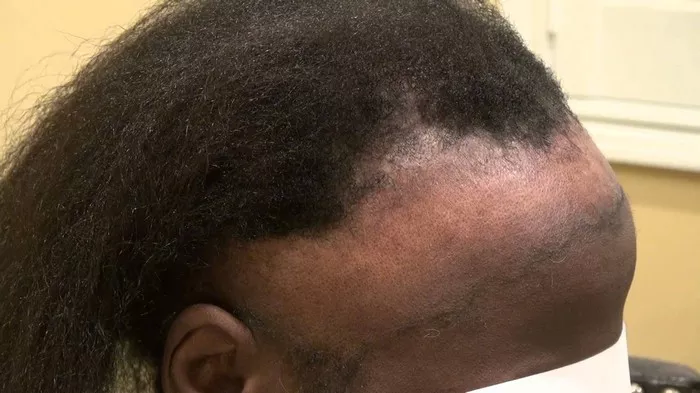Hair loss, a condition that affects millions worldwide, can be particularly distressing for black females. While it’s commonly associated with men, women also experience hair loss, with black women facing unique challenges and causes. Understanding the specific factors contributing to hair loss in black females is crucial for effective prevention and treatment. Among the various types of hair loss, traction alopecia, central centrifugal cicatricial alopecia (CCCA), and breakage are prominent concerns within the black female community. This article aims to delve into the causes, prevention strategies, and treatment options for these conditions.
Traction Alopecia
Traction alopecia is a prevalent form of hair loss among black women, characterized by the gradual thinning of hair due to prolonged tension on the hair follicles. This tension often arises from tight hairstyles that pull at the hair roots, such as braids, weaves, extensions, and dreadlocks.
Definition and Contributing Factors
Traction alopecia is a common type of hair loss in black women caused by tight hairstyles that pull at the hair root. Several factors contribute to its development:
Heat:
Excessive use of heat styling tools like flat irons and curling irons can weaken the hair shaft, making it more susceptible to breakage. The frequent application of high heat levels damages the hair’s protein structure, leading to brittleness and eventual hair loss.
Chemicals:
Chemical relaxers and dyes, often used to straighten or color the hair, can cause significant damage if not applied correctly. Improper application or overuse of these chemicals weakens the hair shaft, making it prone to breakage and eventual loss.
Tight Styles:
Hairstyles that exert constant tension on the hair follicles, such as tight braids, dreadlocks, extensions, and weaves, contribute to traction alopecia. The repeated pulling and tugging on the hair roots weaken them over time, leading to hair loss along the affected areas.
Prevention
Preventing traction alopecia involves adopting hair care practices that minimize tension on the hair follicles:
- Opt for looser braids or dreadlocks to reduce strain on the hair roots.
- Remove braids after three months and extensions after eight weeks to allow the hair follicles to rest and recover.
- Avoid chemical treatments if you notice signs of breakage or shedding, and opt for natural or less harsh alternatives.
- Minimize the use of heat styling tools and always use a heat protectant product before applying heat to the hair.
- Central Centrifugal Cicatricial Alopecia (CCCA)
Central centrifugal cicatricial alopecia (CCCA) is another prevalent form of hair loss in black women, characterized by the progressive destruction of hair follicles and subsequent scarring. This condition typically begins at the crown of the head and radiates outward in a circular pattern.
Cause and Symptoms
Repeated use of tight hairstyles such as braids, weaves, cornrows, and chemical relaxers contributes to the development of CCCA. The constant tension and trauma inflicted on the hair follicles lead to inflammation, scarring, and eventual hair loss. Symptoms of CCCA include balding in the crown of the head, often accompanied by itching, burning, or tenderness in the affected area.
Treatment
Treatment for CCCA aims to reduce inflammation and prevent further hair loss. Options include:
1. Topical corticosteroids: These medications help reduce inflammation and suppress the immune response in the affected area.
2. Injected corticosteroids: Injections of corticosteroids directly into the scalp can provide targeted treatment for areas of significant inflammation.
3. Antibiotics: In cases where secondary infections occur due to scratching or open sores, antibiotics may be prescribed to prevent further complications.
Breakage
Hair breakage, while not a form of hair loss affecting the follicle, is a common issue among black women. It occurs when the hair shaft becomes weakened and snaps off, often due to excessive heat or chemical damage.
Cause
Damage to the hair shaft, rather than the follicle itself, is the primary cause of breakage. Factors contributing to breakage include:
1. Excessive heat styling: Prolonged exposure to high temperatures from styling tools weakens the hair shaft, making it more prone to breakage.
2. Chemical damage: Over-processing the hair with relaxers, dyes, or other chemical treatments can strip the hair of its natural oils and weaken its structure, leading to breakage.
Treatment
Preventing breakage involves adopting gentle hair care practices and providing adequate nourishment to the hair shaft:
- Avoiding practices that cause breakage, such as excessive heat styling or over-processing with chemicals.
- Using moisturizing and strengthening treatments, such as deep conditioning masks or protein treatments, to fortify the hair shaft and reduce breakage.
- Consider using topical medications or oils that promote hair strength and elasticity, such as coconut oil or castor oil.
General Tips for Hair Health
In addition to specific prevention and treatment strategies for hair loss and breakage, black women can promote overall hair health through various lifestyle factors:
1. Healthy Diet: Consuming a balanced diet rich in essential vitamins and minerals, particularly iron, zinc, vitamin D, and protein, supports hair growth and strength.
2. Mental Health: Managing stress levels and prioritizing mental well-being can help reduce hair loss caused by stress-induced factors.
3. Routine Checkups: Regular monitoring of health markers such as anemia, vitamin D levels, and thyroid hormones can help identify and address underlying issues contributing to hair loss.
4. Seek Professional Help: Consulting a dermatologist or trichologist if experiencing persistent or severe hair loss symptoms is crucial for accurate diagnosis and personalized treatment recommendations.
In conclusion, hair loss in black females can stem from various factors, including traction alopecia, central centrifugal cicatricial alopecia (CCCA), and breakage. Understanding the specific causes and adopting appropriate prevention and treatment strategies is essential for maintaining healthy hair and addressing hair loss concerns. By prioritizing gentle hair care practices, nourishing the hair shaft, and addressing underlying health issues, black women can effectively manage hair loss and promote optimal hair health and growth.


